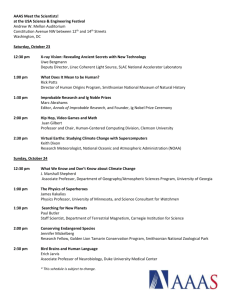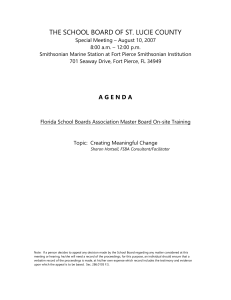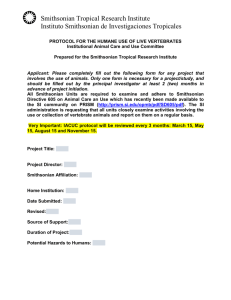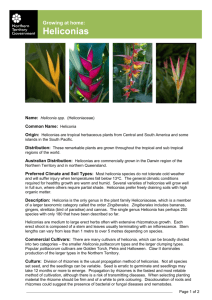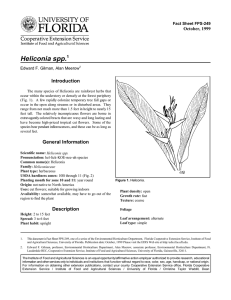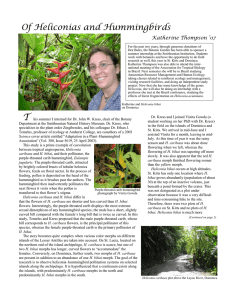I
advertisement
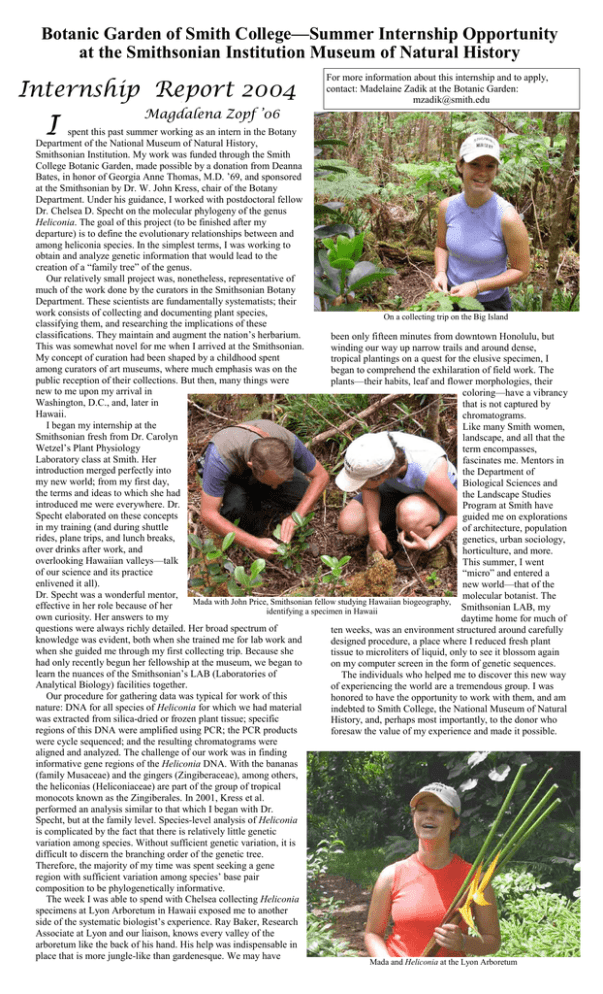
Botanic Garden of Smith College—Summer Internship Opportunity at the Smithsonian Institution Museum of Natural History Internship Report 2004 I For more information about this internship and to apply, contact: Madelaine Zadik at the Botanic Garden: mzadik@smith.edu Magdalena Zopf ’06 spent this past summer working as an intern in the Botany Department of the National Museum of Natural History, Smithsonian Institution. My work was funded through the Smith College Botanic Garden, made possible by a donation from Deanna Bates, in honor of Georgia Anne Thomas, M.D. ’69, and sponsored at the Smithsonian by Dr. W. John Kress, chair of the Botany Department. Under his guidance, I worked with postdoctoral fellow Dr. Chelsea D. Specht on the molecular phylogeny of the genus Heliconia. The goal of this project (to be finished after my departure) is to define the evolutionary relationships between and among heliconia species. In the simplest terms, I was working to obtain and analyze genetic information that would lead to the creation of a “family tree” of the genus. Our relatively small project was, nonetheless, representative of much of the work done by the curators in the Smithsonian Botany Department. These scientists are fundamentally systematists; their work consists of collecting and documenting plant species, On a collecting trip on the Big Island classifying them, and researching the implications of these classifications. They maintain and augment the nation’s herbarium. been only fifteen minutes from downtown Honolulu, but This was somewhat novel for me when I arrived at the Smithsonian. winding our way up narrow trails and around dense, My concept of curation had been shaped by a childhood spent tropical plantings on a quest for the elusive specimen, I among curators of art museums, where much emphasis was on the began to comprehend the exhilaration of field work. The public reception of their collections. But then, many things were plants—their habits, leaf and flower morphologies, their new to me upon my arrival in coloring—have a vibrancy Washington, D.C., and, later in that is not captured by Hawaii. chromatograms. I began my internship at the Like many Smith women, Smithsonian fresh from Dr. Carolyn landscape, and all that the Wetzel’s Plant Physiology term encompasses, Laboratory class at Smith. Her fascinates me. Mentors in introduction merged perfectly into the Department of my new world; from my first day, Biological Sciences and the terms and ideas to which she had the Landscape Studies introduced me were everywhere. Dr. Program at Smith have Specht elaborated on these concepts guided me on explorations in my training (and during shuttle of architecture, population rides, plane trips, and lunch breaks, genetics, urban sociology, over drinks after work, and horticulture, and more. overlooking Hawaiian valleys—talk This summer, I went of our science and its practice “micro” and entered a enlivened it all). new world—that of the Dr. Specht was a wonderful mentor, molecular botanist. The Mada with John Price, Smithsonian fellow studying Hawaiian biogeography, effective in her role because of her Smithsonian LAB, my identifying a specimen in Hawaii own curiosity. Her answers to my daytime home for much of questions were always richly detailed. Her broad spectrum of ten weeks, was an environment structured around carefully knowledge was evident, both when she trained me for lab work and designed procedure, a place where I reduced fresh plant when she guided me through my first collecting trip. Because she tissue to microliters of liquid, only to see it blossom again had only recently begun her fellowship at the museum, we began to on my computer screen in the form of genetic sequences. learn the nuances of the Smithsonian’s LAB (Laboratories of The individuals who helped me to discover this new way Analytical Biology) facilities together. of experiencing the world are a tremendous group. I was Our procedure for gathering data was typical for work of this honored to have the opportunity to work with them, and am nature: DNA for all species of Heliconia for which we had material indebted to Smith College, the National Museum of Natural was extracted from silica-dried or frozen plant tissue; specific History, and, perhaps most importantly, to the donor who regions of this DNA were amplified using PCR; the PCR products foresaw the value of my experience and made it possible. were cycle sequenced; and the resulting chromatograms were aligned and analyzed. The challenge of our work was in finding informative gene regions of the Heliconia DNA. With the bananas (family Musaceae) and the gingers (Zingiberaceae), among others, the heliconias (Heliconiaceae) are part of the group of tropical monocots known as the Zingiberales. In 2001, Kress et al. performed an analysis similar to that which I began with Dr. Specht, but at the family level. Species-level analysis of Heliconia is complicated by the fact that there is relatively little genetic variation among species. Without sufficient genetic variation, it is difficult to discern the branching order of the genetic tree. Therefore, the majority of my time was spent seeking a gene region with sufficient variation among species’ base pair composition to be phylogenetically informative. The week I was able to spend with Chelsea collecting Heliconia specimens at Lyon Arboretum in Hawaii exposed me to another side of the systematic biologist’s experience. Ray Baker, Research Associate at Lyon and our liaison, knows every valley of the arboretum like the back of his hand. His help was indispensable in place that is more jungle-like than gardenesque. We may have Mada and Heliconia at the Lyon Arboretum
